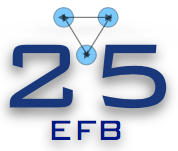Conveners
Wednesday Plenary Session (AudiMax)
- Giuseppina Orlandini (Università di Trento)
The formalism of finite-volume quantisation allows for a rigorous treatment of hadronic resonances and interactions in lattice QCD. I review the status of calculations of baryon-baryon states by the Mainz and BaSc collaborations, with a particular focus on the H dibaryon and nucleon-nucleon interactions. The binding energy of the H dibaryon in
three-flavour QCD in the continuum limit has...
Quantum computers hold great promise for exact simulations of nuclear dynamical processes (e.g., scattering and reactions), which are paramount to the study of nuclear matter at the limit of stability and in the formation of chemical elements in stars. However, achieving this goal presents both conceptual and technological challenges, from formulating model mapping, quantum algorithms and...
Antihydrogen, the bound state of an antiproton and a positron is an eminent system for testing fundamental symmetries of nature. It is calculable from first principles, and the standard model predicts that its energy spectrum should be identical to that of hydrogen to any precision. Its neutrality lends itself to also be a probe of the weak equivalence principle for antimatter free fall....

